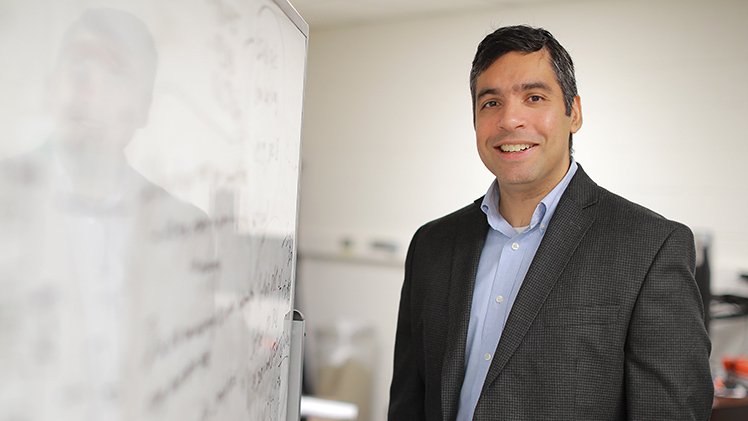Nuclear power has a flexibility problem.
Nuclear power plants are not easily scaled up or down in response to demand on the electrical grid, which those in the industry have long acknowledged is one key drawback to this emission-free energy source. And that drawback will only become more pronounced as intermittent renewable energy resources like wind and solar increasingly enter the energy market, financially incentivizing plants to respond to resulting periods of high and low energy production.

Dr. Raghav Khanna is exploring ways to maximize the flexibility and profitability of nuclear power plants in collaboration with the U.S. Department of Energy’s Idaho National Laboratory.
The University of Toledo’s Dr. Raghav Khanna is engineering a solution to this flexibility problem.
In collaboration with the U.S. Department of Energy’s Idaho National Laboratory, and along with Dr. Ahmad Javaid, an associate professor in the Department of Electrical Engineering and Computer Science, and Dr. Mike Heben, a Distinguished University Professor and PVIC Endowed Chair in the Department of Physics and Astronomy, Khanna is exploring ways to maximize the flexibility and profitability of nuclear power plants by integrating renewable energy resources and hydrogen production. Their deep reinforcement learning model has calculated that such an adjustment would increase revenue at a plant by more than 25% over 120 days.
With their most recent round of funding from the national laboratory, which began in November, the team is to refine this model and further their research into the nuclear-renewable integrated energy systems that could shift energy production away from fossils fuels.
“Our goal is to demonstrate the flexibility, adaptability and profitability of our system,” said Khanna, the Leidich Family Endowed Professor of Power Systems in the UToledo College of Engineering’s Department of Electrical Engineering and Computer Science.
Power systems are a wide-reaching specialty covering the generation, distribution and transmission of power. Other examples of Khanna’s work include ongoing research into the semiconductor gallium nitride backed by the Office of Naval Research. He’s looking into its potential for enabling smaller, more efficient microgrids that could be installed aboard military ships.
He and Dr. Daniel Georgiev, another professor in the Department of Electrical Engineering and Computer Science, also recently wrapped up research into radiation-tolerant solar-power conversion systems in space – a project supported by NASA’s Jet Propulsion Laboratory.
Khanna and his team have been collaborating with Idaho National Lab on nuclear-renewable integrated energy systems since 2020. This line of research aligns with a nationwide push to explore hydrogen as a source of clean energy, as demonstrated by the U.S. Department of Energy allocating $7 billion to seven regional clean hydrogen hubs under the Bipartisan Infrastructure Law in October.
Khanna’s ongoing work is independent of a regional hydrogen hub. He’s been exploring ways to retrofit nuclear power plants to also generate and store hydrogen, with the stored hydrogen playing a key role in improving the entire system’s flexibility.
He and his collaborators at UToledo and Idaho National Laboratory described their proposed system in Applied Energy in December 2022, and later presented it at the Institute of Electrical and Electronics Engineers’ Power & Energy Society General Meeting in July 2023. It calls for the installation of solid oxide electrolyzer cell and solid oxide fuel cell systems into nuclear renewable energy systems. The solid oxide electrolyzer cell uses the thermal energy produced by the nuclear to split water – already onsite for nuclear power production – into oxygen and hydrogen; that hydrogen can either be stored or directed to paying end-users. The solid oxide fuel cell converts stored hydrogen into electricity.
Whenever the price of electricity is low, which generally means demand is likewise low, the electrolyzer cell would kick in to produce hydrogen. Whenever it’s high, which generally means that demand is likewise high, the fuel cell would kick in to convert stored hydrogen to electricity.
“Because we can draw on the stored hydrogen as needed, we can more easily scale the production or electricity up and down in response to demand on the grid,” Khanna said. “That means the entire system is more flexible and ultimately more profitable.”
Of course, those energy-dispatching decisions are significantly more complex than the price of electricity at any given time. That’s where the deep reinforcement learning model comes in, taking into account factors like the weather, time of day and availability of renewable energy resources.
“We’ll be adding more detail to this model going forward,” Khanna said. “We hope it can be a blueprint to revitalize power plants in a way that makes sense financially and environmentally.”
All of this has been – and will be – possible with the assistance of students who work in his lab.
“They are the ones who are doing the real work, and they deserve all the credit,” he said.